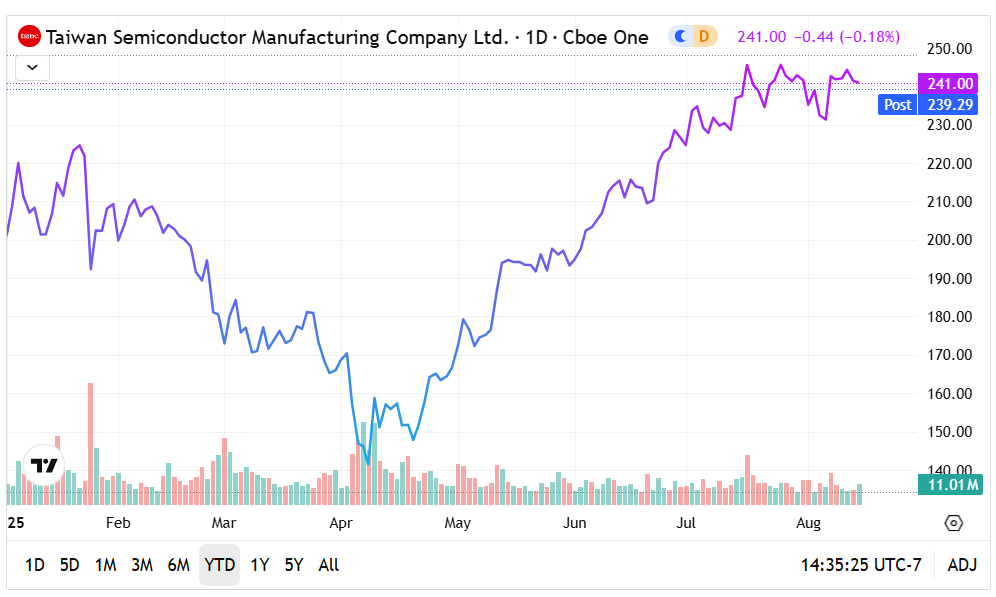
As the world's largest pure-play foundry, Taiwan Semiconductor Manufacturing Co. (NYSE:TSM) — often abbreviated as TSMC — plays a critical role in the global semiconductor value chain. Late last year, International Data Corp stated that the company could expand its market share in the foundry industry to 36% by the end of this year, rising from 33% in 2024.
Not surprisingly, TSM stock has responded well to the broader enthusiasm, backed by tremendous demand for artificial intelligence. On a year-to-date basis, TSM has gained just over 22% as of the close of the Aug. 14 session. This return stemmed from explosive performance since early April. However, since around mid-July, the upswing has noticeably flatlined, leading to questions about forward viability.

On paper, circumstances seem conducive for a resumption of bullish momentum. In the company's second-quarter disclosure, TSMC posted earnings per share of $2.47, beating Wall Street analysts' consensus view of $2.37. This figure also represented a significant lift against the year-ago-quarter's EPS of $1.48. On the top line, the semiconductor giant edged past the consensus target with $30.07 billion. Last year, TSMC rang up $20.82 billion.
As expected, the chipmaker benefited from insatiable global demand for its advanced processor technologies that are essential for AI-based applications. Further, TSMC represents a key supplier to tech juggernauts like Nvidia Corp (NASDAQ:NVDA) and Apple Inc (NASDAQ:AAPL). As such, the company legitimately commands potential for greater growth. Indeed, management provided an optimistic revenue forecast for the third quarter, instilling broader confidence in TSM stock.
Still, not every fundamental line item aligns with the bullish narrative. In June, TSMC acknowledged that the tariffs imposed by the Trump administration have created some headwinds, albeit indirectly. To be sure, the semiconductor giant noted that demand for AI-related chips remains exceptionally strong, which the Q2 report highlighted. Nevertheless, TSMC also noted that higher prices from tariffs may negatively affect demand.
There's also the problem that success can breed its own challenges. As noted last year, TSMC has been grappling with escalating electricity costs, significantly impacting its operations. Due to a combination of electricity price hikes and Taiwan's shift toward renewable energy (and thus the phasing out of nuclear power), the headwinds are straining the foundry giant. Plus, TSMC has also had to deal with disruptions related to natural disasters.
The Direxion ETFs: With myriad intriguing talking points from both sides of the sentiment aisle, traders have ample opportunity to speculate. To serve a diverse audience base, Direxion introduced two TSMC-focused exchange-traded funds. For the optimist, the Direxion Daily TSM Bull 2X Shares (NASDAQ:TSMX) seeks the daily investment results of 200% of the performance of TSM stock. On the other end, the Direxion Daily TSM Bear 1X Shares (NASDAQ:TSMZ) seeks 100% of the inverse performance of the namesake equity.
One of the main drivers for Direxion ETFs is convenience. Usually, traders interested in leveraged or short positions must engage the options market. However, financial derivatives carry complexities that may not be suitable for all market participants. In contrast, Direxion ETFs can be bought and sold much like any other publicly traded security, thus mitigating the learning curve and making the process more intuitive.
Still, interest traders must recognize these funds' unique risk profile. First, leveraged and inverse ETFs typically incur greater volatility than funds tracking benchmark indices, such as the Nasdaq Composite index. Second, Direxion ETFs are designed for exposure lasting no longer than one day. Holding these ETFs longer than recommended may expose traders to value decay due to the daily compounding effect.
The TSMX ETF: Since the start of the year, the TSMX ETF has gained more than 21%, which is conspicuously lower than the underlying anchor.
TSMX's apparent performance drag represents a real-world reminder that volatility in leveraged funds can impose a disproportionate impact.
While the TSMX ETF is treading above the 20-day exponential moving average, investors must be cognizant of the lack of forward momentum since mid-July.

The TSMZ ETF: Predictably, the TSMZ ETF has dropped 26% since the January opener, though the bleeding has diminished considerably.
From a technical standpoint, the TSMZ ETF sits below the key benchmarks of the 20-day EMA and 50 DMA, implying negative sentiment.
Still, in the past five sessions, TSMZ has actually moved up a hair, opening the possibility of a sentiment reversal favoring bearish speculators.

Featured image by foto qin from Pixabay.







